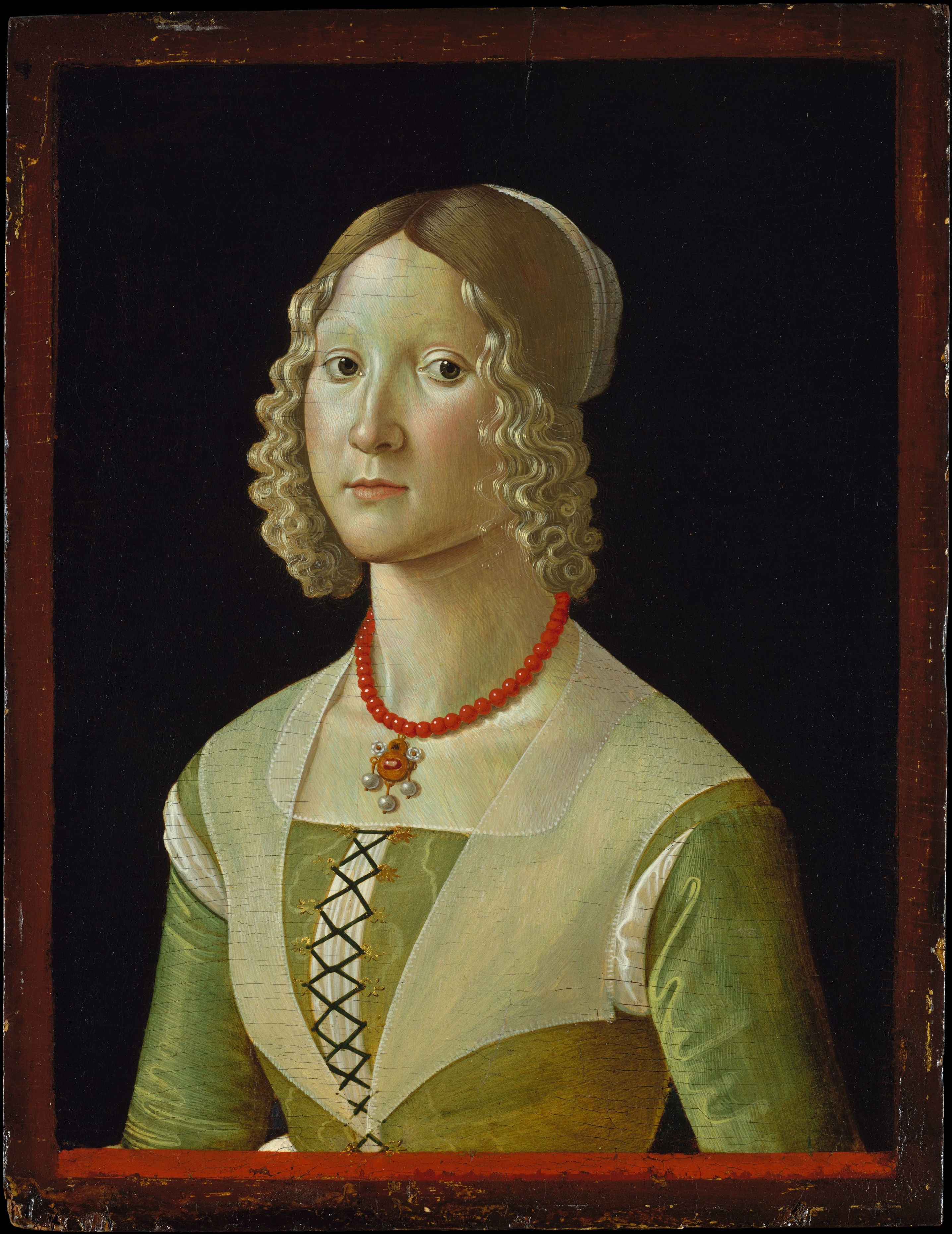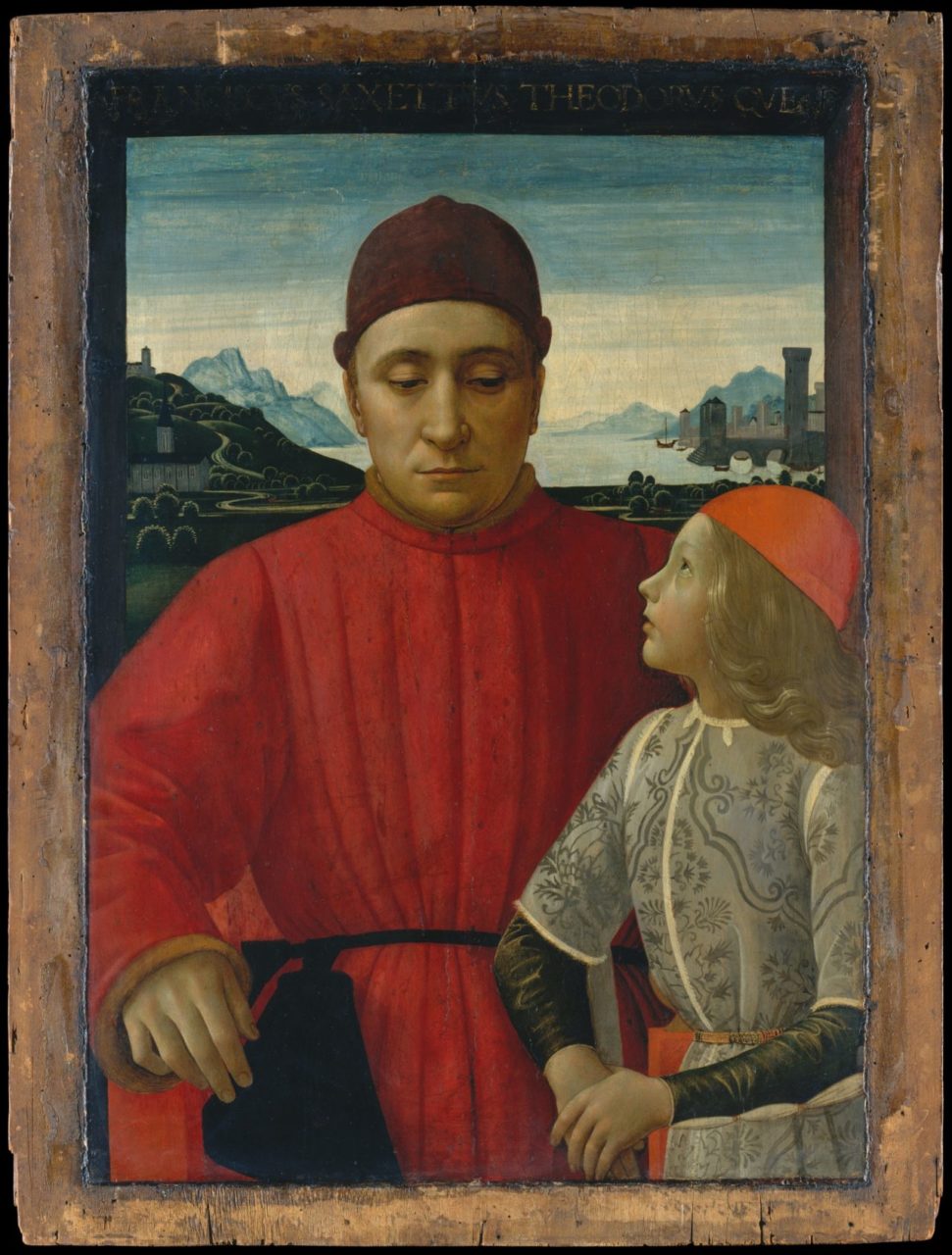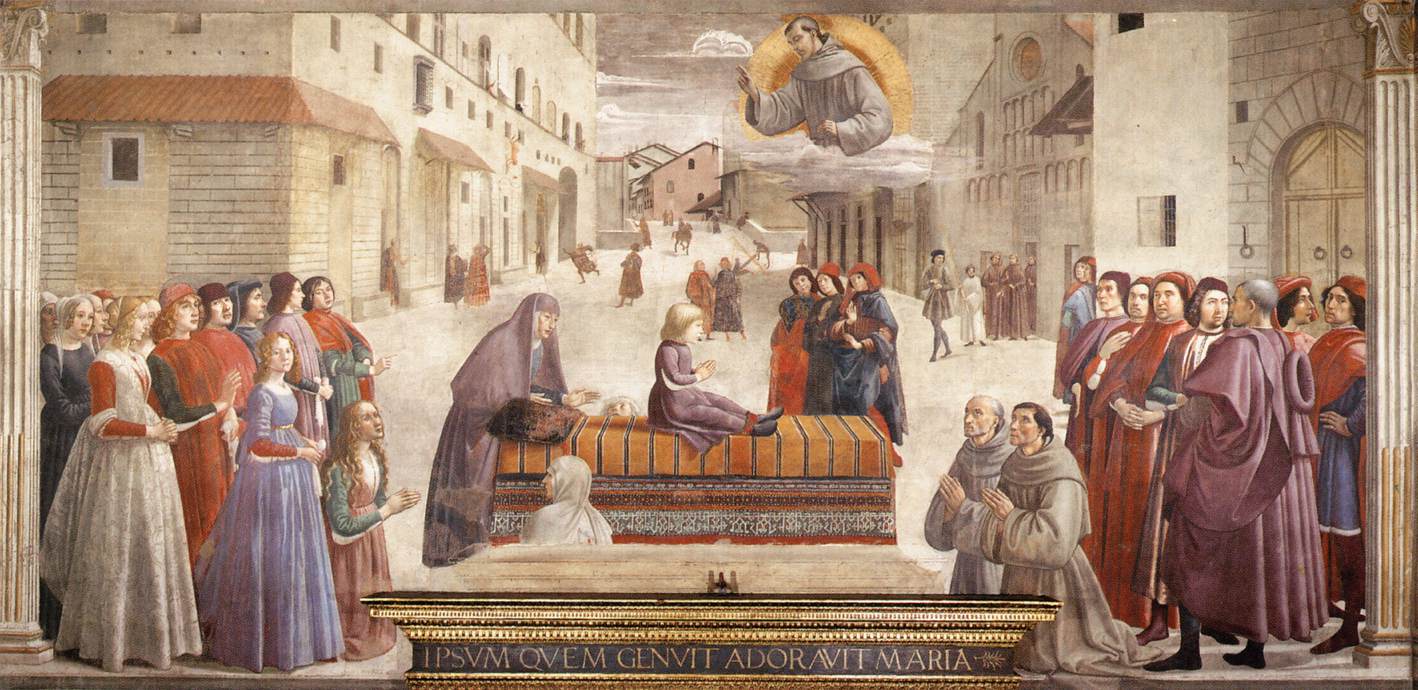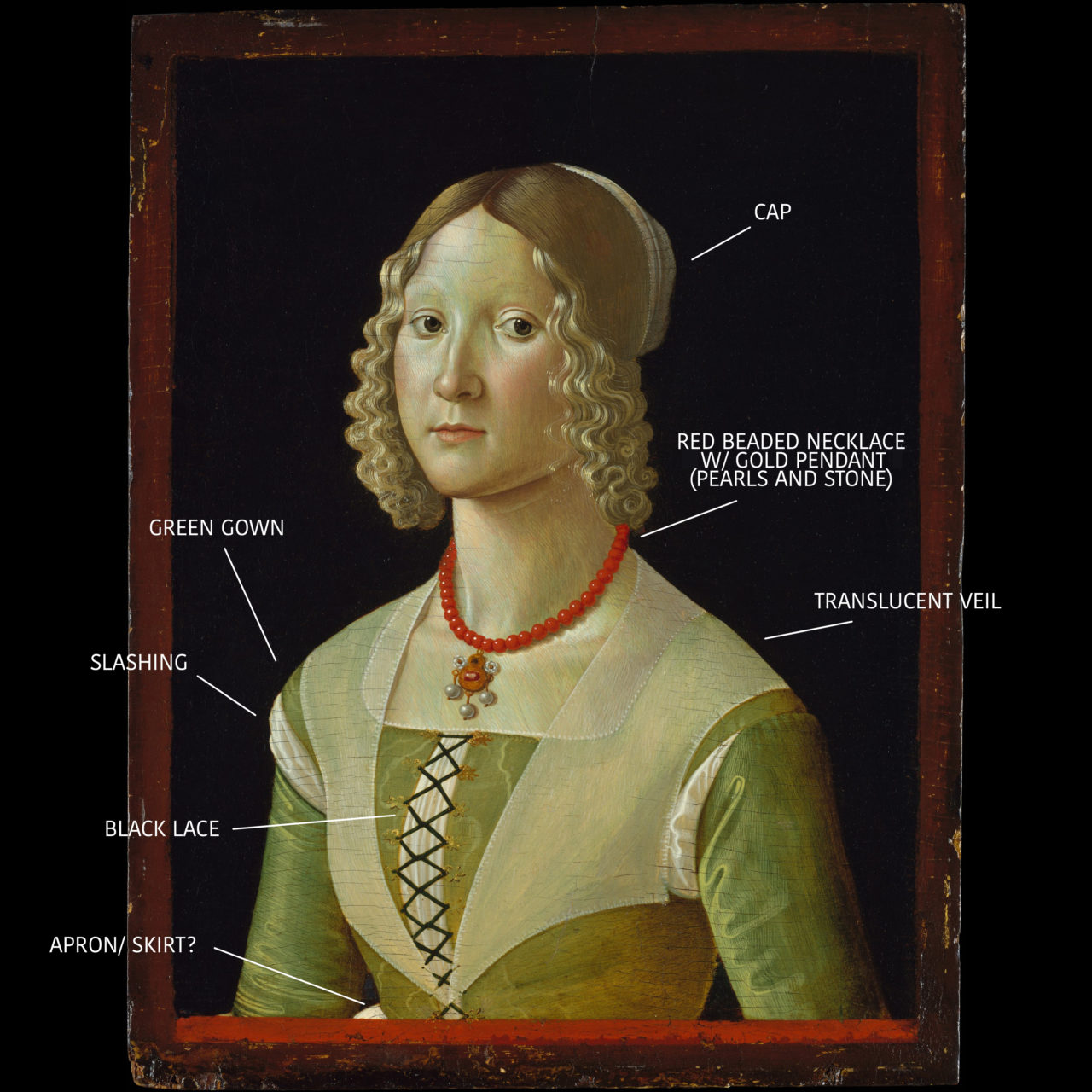Selvaggia may not be the most fashionable and extravagant person of her time, but we cannot be sure about that until the rest of her dress is revealed.
About the Portrait
Davide Ghirlandaio (1452–1525) was an Italian artist known for his mosaics and paintings, as art historian Jean Cadogan notes. He worked heavily under his brother Domenico Ghirlandaio as an assistant during the earlier part of his artistic career. After his brother died, Davide took over the role as head of their workshop and carried forward on commissions. Although he was mostly commissioned for mosaics in cathedrals, there are other recorded works of paintings done for churches and from other patrons (Cadogan). It has been established that Davide of the Ghirlandaio brothers was the painter for Selvaggia Sassetti (born 1470) after closely examining the details in the portrait. As Met museum curator Keith Christiansen notes, it was painted using left-handed brush strokes, which was exclusively done by Davide. Selvaggia Sassetti was the fifth daughter of Francesco Sassetti (Fig. 1), an Italian banker, and her portrait was most likely painted for her marriage. However, she appears younger in the painting, since it was commissioned three years before her actual marriage (Christiansen 118). Another painting of Selvaggia exists in The Resurrection of a Boy (Fig. 2), a mural for the Sassetti Chapel in Florence, Italy, which Domenico painted instead. In that fresco, Selvaggia is painted as a full-body portrait wearing a light blue dress in the foreground. Although painted by two different brothers, both artists captured the similar gaze and alertness of the young girl.
Fig. 1 - Domenico Ghirlandaio (Italian, 1448/49–1494). Francesco Sassetti (1421–1490) and His Son Teodoro, ca. 1488. Tempera on wood; 84.5 x 63.8 cm (33 1/4 x 25 1/8 in). New York: The Metropolitan Museum of Art, 49.7.7. The Jules Bache Collection, 1949. Source: The Metropolitan Museum of Art
Fig. 2 - Domenico Ghirlandaio 1482-1485. (Italian, 1448/49–1494). The Resurrection of the Boy, 1482-1485. Fresco. Florence: Santa Trinita, Sassetti chapel. Source: Eurocles
Davide Ghirlandaio (Italian, Florence 1452–1525). Selvaggia Sassetti (born 1470), ca. 1487–88. Tempera on wood; 57.2 x 44.1 cm (22 1/2 x 17 3/8 in.). New York: Metropolitan Museum of Art, 1931. 32.100.71. The Friedsam Collection, Bequest of Michael Friedsam. Source: The Met

About the Fashion
Selvaggia wore a fitted, green silk gown with an attached translucent veil wrapped over her shoulder. The green gown is fastened with a black lacing in a simple crisscross manner, which exposes a inner white blouse with compressed folds. Also, the shoulders have open seams in the tight fitting sleeves that, again, reveal the blouse underneath. Her gown has a rectangular neckline, exposing her neck and collarbone. In terms of accessories, she is minimalistic but bold. In the painting, she wears an eye-catching, bright red beaded necklace, perhaps made of coral, with a round gold pendant mounted with a red stone in the center, as well as two rose-shaped ornament attached to the side and three pearls hanging from below. It stands out against her pale complexion and complements the green of her gown. Her hair is exposed with curly locks framing her face, and the rest of her hair is neatly tied and tucked into a cream-colored cap in the back. Although it is unclear what the rest of her gown below looked like, in the small nook between her right arm and waist, there is a small triangular cloth peaking up, which may be an attached apron. Selvaggia is dressed quite modestly and elegantly, but not quite extravagantly. Even so, based on her costume, she still seemed to be part of the upper class; her dress seems to be made of watered silk. Not to mention that her father is a banker and could afford to commission several paintings of her that depict her wearing a valuable gold necklace. Interestingly, Selvaggia’s gown is simple and lacks a brocaded pattern design, which was common for rich women in the 15th century. According to European Costume – 4000 Years of Fashion (1982) by Doreen Yarwood what marks the fashion trend of the 14th to 15th century was the luxurious taste in what kinds of fabric people wore:
“An important feature of fourteenth-and fifteenth-century dress was the richness of the materials from which it was made and with which was ornamented. All through these years, a great expansion took place in the manufacture, importation and spread of such fabrics. In the west, Italy was the chief source. Especially in the northern half of the country, in centers such as Lucca and Venice, luxury materials like silk, satin, velvet and taffeta were made in quantity and exported all over Europe. Spain also developed a silk industry under Moorish initiative. Both countries were extensive users themselves of these materials, rich in color and pattern. Woollen and linen fabrics were manufactured in even greater quantity, for only the wealthy could afford luxury materials.” (52-53)
This could indicate that although her family has money, they preferred a simpler look in their portraits at least. Compared to other portraits done during the same time period, the women in other paintings are dressed more luxuriously.
Fig. 3 - Bartolomeo Montagna (Italian, 1459–1523). Saint Justina of Padua, 1490s. Oil on wood; 48.6 x 37.5 cm (19 1/2 x 15 1/8 in). New York: The Metropolitan Museum of Art, 14.40.606. Bequest of Benjamin Altman, 1913. Source: The Metropolitan Museum of Art
Fig. 4 - Ambrogio de Predis (Italian, 1472–1508). Girl with Cherries, ca. 1491–95. Oil on wood; 48.9 x 37.5 cm (19 1/4 x 14 3/4 in). New York: The Metropolitan Museum of Art, 91.26.5. Marquand Collection, Gift of Henry G. Marquand, 1890. Source: The Metropolitan Museum of Art
Fig. 5 - Giovanni Antonio Boltraffio (Italian, 1466/1467 – 1516). Portrait of a Youth Crowned with Flowers, ca. 1490. Oil on panel; 39.1 x 28.9 cm (15 3/8 x 11 3/8 in). North Carolina: North Carolina Museum of Art, GL.60.17.40. Gift of the Samuel H. Kress Foundation. Source: North Carolina Museum of Art
In Bartolomeo Montagna’s Saint Justina of Padua (Fig. 3), patterns and designs in the gown can be seen in the sleeves and bodice along with other embellishments like pearls and jewels attached. She appears to be more fashionable, and with greater wealth, because of the meticulous details in the seams and the ornaments hanging around the shoulders, as well as the accessories in the neck and hairpiece. Other portraits like Girl With Cherries (Fig. 4) and Portrait of a Youth Crowned with Flowers (Fig. 5) by Ambrogio de Predis and Giovanni Antonio Boltraffio respectively, are portrayed with less elaborate designs and ornaments, yet are still decorated with vivid detailed patterns suggesting their high status. Open-seaming and laces in the costumes are also quite common on the sleeves to reveal the under clothing, which is illustrated in all three portraits. Additionally, all these women wore some sort of neck and head accessory with floral and geometric patterns for decoration. Floral and geometric designs were constantly reused and redesigned on many different kinds of costumes such as tunics, gowns, bodices, and hoses. In addition to the variety arrangement of colors on the clothing, Yarwood states that:
“[b]rilliant colors and jeweled embroideries were all the rage. Despite the growth of the luxury textile industry in the west, oriental fabrics were still imported in quantity for those who could afford them. They came from China, Persia and Middle Eastern areas such as Egypt and Damascus. Some were plain, others richly patterned in floral or abstract motifs. Such fabrics were largely copied and redesigned in the for market.” (53- 54)
Analyzing the differences in Selvaggia’s clothing to these other women makes it clear that she may was not necessarily the most fashionable at the time. Her plain and simple look though made of expensive silk material contrasts those that wore fine, detailed designs on their gown with various color and embellishments. Even Selvaggia’s ornamented necklace may seem awkwardly supplemental to the top of her plain, green gown, and that there is an exceeding amount of green on her clothes than the red on the necklace. On the other hand, what these four women have in common is the rectangular neckline, lacing, open seaming on the sleeves, as well as the headpiece. According to History of Costume: From the Ancient Egyptians to the Twentieth Century (1965) by Elizabeth Curtis and Blanche Payne:
“The typical late fifteenth-century gown had a high, ungirdled waistline, deep V-neck filled in with a stomacher, separate sleeves more drastically slashed… and long skirt with easy fullness falling from the waist.” (240)
We can see that these features have applied to most these women, especially in Saint Justina of Padua, and somewhat in Girl With Cherries and Portrait of a Youth Crowned with Flowers. Selvaggia’s portrait shows no sign of a girdle nor stomacher, and is thus withdrawn from the typical style of the 15th century.
Furthermore, in the Concise History of Costume and Fashion (1969) by John Laver, it stated that during the 14th to 15th century:
“The clothes worn by women shared many of the same characteristics as those worn by men. They were made of the same type of fabrics, in the same colors, with the same type of heraldic, floral and geometric patterns; they were parti- colored and counterchanged just the same, the edges of sleeves and hems were dagged and, especially in the fifteenth century, fur trimmings, edgings and linings were general. In cut also there were similarities.” (59)
Men’s and women’s fashion were comparably similar to one another, and both cases desired to dress extravagantly to flaunt beauty and wealth. Laver claims:
“The fourteenth and, even more the fifteenth century, were exceptional years for this expression of the peacock idiosyncrasy, with males always the more gloriously appareled and sexually paramount. Women were elegantly and richly dressed but their femininity was discreetly shown.” (Laver 79)
Portrait of a Young Man by Biagio d’Antonio (Fig. 6) has a similar quality of simplicity as seen in Selvaggia’s portrait. He wears an unhooded chaperon over a fitted velvet doublet, both in the same deep red hue. It is opened at the shoulders where his arm goes through to reveal a whole arm of black sleeve underneath. Small signs of slashing can be seen on cuffs of his right hand, where he grasps the chaperon. Additionally, there is a lack of decoration on his costume, neither pattern or ornament. Unlike what Laver suggests, the man in this portrait does not depict the desire to display his wealth or attract others with the rich quality of his costume (79).
Fig. 6 - Biagio d'Antonio (Italian, 1446- 1516). Portrait of a Young Man, ca. 1470. Tempera on wood; 54.3 x 39.4 cm (21 3/8 x 15 1/2 in). New York: The Metropolitan Museum of Art, 32.100.68. The Friedsam Collection, Bequest of Michael Friedsam, 1931. Source: The Metropolitan Museum of Art
It is clear that there were many differences in Selvaggia’s clothing compared to other existing portraits of women (as well as men) during the same time period, in comparison with them she dresses in a more modest and plain fashion. But it is impossible to determine her true fashionable ideals based on this portrait alone without seeing the rest of the gown and the rest of her wardrobe. She may well be wearing a decorated and embellished skirt, in comparison to the plain bodice, without us even knowing.
References:
- Cadogan, Jean K. and Andrea Muzzi. “Ghirlandaio.” Grove Art Online. Oxford Art Online. Oxford University Press, accessed November 30, 2017, http://www.oxfordartonline.com/subscriber/article/grove/art/T031960pg2.
- Christiansen, Keith, Stefan Weppelmann, and Patricia Lee Rubin. The Renaissance Portrait: From Donatello to Bellini. New Haven: Yale University Press, 2011. http://www.worldcat.org/oclc/711045557
- Laver, John. Concise History of Costume. The World of Art Library. London: Thames and Hudson, 1969. http://www.worldcat.org/oclc/934933119
- Payne, Blanche, and Elizabeth Curtis. History of Costume: From the Ancient Egyptians to the Twentieth Century. New York: Harper and Row, 1965. http://www.worldcat.org/oclc/990364293
- Yarwood, Doreen. European Costume: 4000 Years of Fashion. New York: Bonanza Books, 1982. http://www.worldcat.org/oclc/8171068

















